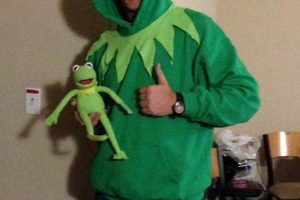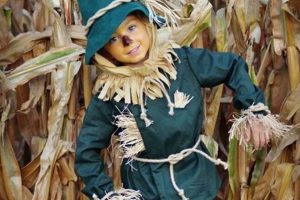Creating a personalized Yuletide character outfit involves the application of do-it-yourself methods to construct apparel reminiscent of Santa’s helpers. This process typically includes the selection of fabrics, the crafting of accessories, and the assembly of components to form a festive and individualized ensemble. For instance, individuals might sew a tunic from green felt, fashion pointed ears from craft foam, and embellish a belt with jingle bells to achieve the desired aesthetic.
Such projects offer multiple advantages, including cost savings when compared to commercially produced alternatives. Furthermore, engaging in the creation of customized garments encourages creativity and self-expression. Historically, the practice of crafting one’s own attire has been a significant aspect of holiday celebrations, fostering a sense of community and shared experience. The result is often a uniquely designed and personally meaningful representation of seasonal figures.
The subsequent sections will detail specific techniques and materials useful for crafting various components of these themed outfits. This includes guidance on sewing patterns, accessory creation, and makeup application for a comprehensive and cohesive finished product.
Tips for DIY Elf Costume Creation
Effective execution of self-assembled Yuletide helper attire requires careful planning and attention to detail. The following suggestions aim to guide the construction process, ensuring a visually appealing and durable final product.
Tip 1: Fabric Selection. Prioritize durable and comfortable materials. Felt is a common choice for its affordability and ease of use, but consider using higher-quality fabrics like broadcloth or velvet for enhanced visual appeal and longevity. Ensure the chosen fabric is colorfast to prevent dye transfer during wear or cleaning.
Tip 2: Pattern Adaptation. Modify existing sewing patterns to achieve the desired elven aesthetic. Focus on creating a tunic or jacket with a pointed hemline and bell sleeves. When adapting patterns, pay close attention to measurements to ensure a proper fit. Test the pattern with inexpensive fabric before cutting into the final material.
Tip 3: Accessory Construction. Ears are a defining characteristic. Craft these from craft foam, felt, or lightweight polymer clay. Secure the ears to a headband or attach them directly to a wig for stability. Consider using spirit gum for temporary adhesion to the skin, following manufacturer’s instructions for safe removal.
Tip 4: Belt Embellishment. Utilize a sturdy belt as a base. Embellish with jingle bells, faux buckles, or ribbon accents. Securely attach these elements using strong adhesives or by sewing them directly to the belt. Consider adding small pouches or bags to the belt for functional and thematic purposes.
Tip 5: Footwear Considerations. Opt for comfortable footwear appropriate for the intended activity. Consider repurposing existing shoes or boots by adding pointed toe covers made from felt or leather. Alternatively, purchase commercially available elf shoes or booties, ensuring they are sized correctly for a secure and comfortable fit.
Tip 6: Color Palette Coordination. Maintain a consistent color scheme throughout the entire design. Traditional colors include shades of green, red, and gold. However, variations using earth tones or pastels can offer a unique and personalized aesthetic. Ensure that all fabric and accessory colors complement each other harmoniously.
Tip 7: Seam Reinforcement. Strengthen seams and stress points, especially around closures and decorative elements. Use a reinforced stitch or apply seam sealant to prevent tearing or separation. Consider adding lining to garments for added durability and comfort.
Adhering to these guidelines will contribute to the creation of a well-constructed and visually compelling Yuletide helper ensemble. Attention to detail and a focus on durability will ensure a garment that can be enjoyed for multiple seasons.
The concluding section will provide insights into makeup techniques and final styling tips to complete the overall transformation.
1. Fabric Selection
Fabric selection is a foundational element in the creation of self-assembled Yuletide helper apparel. The material chosen significantly impacts the visual appeal, comfort, durability, and overall success of the project.
- Aesthetic Considerations
The choice of fabric directly influences the costume’s visual presentation. Fabrics like velvet or satin impart a luxurious and sophisticated appearance, while felt or cotton offer a more rustic and homespun aesthetic. The selection should align with the desired character portrayal and the intended level of formality. For example, a fine velvet could be used for an aristocratic elf, while roughspun linen might suit a woodland elf.
- Comfort and Wearability
Comfort is paramount, especially for costumes intended for extended wear. Fabrics that are soft, breathable, and non-irritating are preferred. Natural fibers like cotton or linen are generally more comfortable than synthetic alternatives. The fabric’s weight and texture also affect comfort; heavier fabrics may be warmer but less flexible, while lighter fabrics offer greater freedom of movement.
- Durability and Maintenance
The selected material should withstand the intended use and be relatively easy to maintain. Fabrics prone to wrinkling, tearing, or fading may detract from the costume’s appearance over time. Durable fabrics like broadcloth or twill are suitable for costumes that will be worn frequently or subjected to rough handling. Care instructions should also be considered, as some fabrics require specialized cleaning methods.
- Cost and Availability
Budgetary constraints often influence fabric choices. Inexpensive options like felt or cotton are readily available and easy to work with. However, higher-quality fabrics may offer a more professional and polished look. The availability of specific colors and patterns may also limit choices. Balancing cost with desired aesthetic and durability is a crucial aspect of the selection process.
The interconnectedness of these factors underscores the critical role of thoughtful fabric selection in crafting successful and satisfying self-made Yuletide helper attire. Each choice made during this process impacts not only the costume’s final appearance, but also its comfort, longevity, and overall value. Prioritizing these considerations ensures that the final product is not only visually appealing but also functional and enjoyable to wear. For instance, a balance between cost and durability might lead one to select a durable but affordable broadcloth for a child’s costume that will see much wear and tear.
2. Pattern adaptation
Pattern adaptation constitutes a critical phase in the creation of self-assembled Yuletide helper attire. Pre-existing sewing patterns rarely align perfectly with the specific design elements or desired fit of an elven costume. This necessitates modifications to existing patterns or the creation of entirely new ones. The complexity of the adaptation required is directly proportional to the deviation from standard garment construction. For example, a basic tunic pattern might require alterations to incorporate a pointed hem, exaggerated sleeves, or an asymmetrical closure, all characteristic features of elven garb. A failure to accurately adapt a pattern can result in a poorly fitting or aesthetically unconvincing costume, thereby diminishing the overall impact of the endeavor. The process typically involves adjusting measurements, reshaping pattern pieces, and potentially adding entirely new components to achieve the desired elven silhouette.
Practical application of pattern adaptation techniques involves understanding basic pattern-making principles, such as dart manipulation, adding seam allowances, and adjusting for ease of movement. For instance, adapting a standard pants pattern to create elf-like leggings may require reducing the width of the legs, adding elastic at the ankles, and incorporating decorative elements like stripes or scalloped edges. Similarly, a commercially available vest pattern could be modified to create a jerkin with a unique closure and exaggerated collar. Successful pattern adaptation frequently relies on iterative adjustments and the creation of muslin mock-ups to test the fit and proportions before cutting into the final fabric. This iterative process minimizes the risk of costly errors and ensures a more refined and professional outcome.
In summary, pattern adaptation is an indispensable element in the successful execution of self-made Yuletide helper attire. Challenges associated with this process often stem from a lack of familiarity with pattern-making techniques or an underestimation of the alterations required to achieve the desired aesthetic. Overcoming these challenges necessitates a combination of technical skill, creative vision, and a willingness to experiment. The successful integration of pattern adaptation into the construction process links directly to the broader theme of personalized expression and cost-effective resourcefulness inherent in the creation of do-it-yourself holiday costumes.
3. Accessory crafting
The creation of accessories represents a pivotal component in the successful execution of self-assembled Yuletide helper attire. These supplementary items contribute significantly to the overall aesthetic coherence and thematic authenticity of the finished ensemble.
- Ear Fabrication
The design and construction of elven ears are paramount. These can be fashioned from diverse materials such as craft foam, felt, or lightweight polymer clay. The ears may be secured to a headband, attached directly to a wig, or affixed to the skin using cosmetic adhesive. Variations in size, shape, and degree of pointedness allow for individual expression and stylistic interpretation.
- Headwear Embellishment
Elven costumes often incorporate headwear ranging from simple hats to elaborate circlets. These items can be constructed from fabric, leather, or metallic materials. Embellishments such as feathers, beads, or miniature bells further enhance the visual impact. The style of headwear should complement the overall design of the costume.
- Footwear Modification
Existing footwear can be adapted to create elven-style shoes or boots. Pointed toe covers, crafted from felt or leather, can be attached to standard shoes. Alternatively, commercially available elf shoes or booties can be incorporated. Considerations include comfort, practicality, and adherence to the costume’s color scheme.
- Belt and Pouch Creation
Belts serve both functional and decorative purposes. They can be crafted from leather, fabric, or rope and embellished with buckles, studs, or decorative stitching. Small pouches or bags can be attached to the belt to carry accessories or small props, enhancing the character’s believability.
These varied accessories are integral to elevating a basic garment into a convincing representation of a Yuletide helper. Thoughtful planning and careful execution of accessory crafting contribute significantly to the overall success and visual impact of the self-made ensemble. For example, meticulously crafted leather bracers could complement a more rugged, forest-dwelling elf design, highlighting the potential for accessories to define and enhance a costume’s overall narrative.
4. Color coordination
Effective color coordination plays a crucial role in achieving a visually cohesive and thematically accurate self-assembled Yuletide helper ensemble. Color choices significantly influence the costume’s overall impact and contribute to its believability. Inadequate color coordination can detract from the intended effect, regardless of the craftsmanship applied to individual components.
- Harmonious Palette Selection
Selecting a harmonious color palette is fundamental to successful color coordination. Traditional palettes often incorporate shades of green, red, and gold, reflecting established festive associations. However, alternative palettes, such as earth tones or pastels, can offer a unique and personalized aesthetic. The key is to ensure that all selected colors complement each other, creating a visually pleasing balance. For instance, pairing a deep forest green with a muted gold and a touch of crimson can evoke a classic elven look, while a palette of pale greens, silvers, and icy blues can suggest a snow elf.
- Fabric and Material Consistency
Maintaining consistency in color across different fabrics and materials is essential. Variations in dye lots or material composition can lead to noticeable discrepancies in color, undermining the overall aesthetic. It is advisable to source all materials from a single supplier or to carefully compare colors under consistent lighting conditions before beginning construction. Where complete consistency is unattainable, consider using variations in texture or pattern to subtly blend disparate shades. For example, slight color differences between a velvet tunic and a felt hat can be mitigated by adding decorative embroidery that ties the two elements together.
- Accent Color Placement
Strategic placement of accent colors can enhance visual interest and draw attention to specific details. Accent colors should be used sparingly to highlight key features, such as trim, accessories, or embellishments. The choice of accent colors should complement the primary palette and contribute to the overall thematic impression. For example, using gold as an accent color on a predominantly green costume can emphasize the character’s status or role. Conversely, using a contrasting color, such as purple or blue, can introduce an element of whimsy or individuality.
- Lighting and Environmental Considerations
The perceived colors of a costume can vary depending on the lighting conditions and the surrounding environment. It is important to consider how the costume will appear under different lighting scenarios, such as indoor l
ighting, outdoor daylight, or stage lighting. Certain colors may appear washed out or distorted under specific lighting conditions. Adjustments to color intensity or saturation may be necessary to compensate for these effects. For instance, a costume designed for wear at an outdoor festival may require brighter, more saturated colors than one intended for an indoor performance.
These facets of color coordination are interconnected and contribute significantly to the overall success of a self-made Yuletide helper ensemble. Thoughtful planning and careful execution of color choices enhance the visual impact of the costume, reinforcing its thematic authenticity. By attending to these details, creators can elevate their designs from simple garments to compelling representations of elven characters. The application of these principles is not limited to color alone, but exemplifies a holistic approach to design, where every element works in concert to achieve a unified and persuasive aesthetic.
5. Finishing details
The successful realization of self-constructed Yuletide helper attire hinges significantly upon the meticulous execution of finishing details. These seemingly minor elements collectively contribute to the overall quality, durability, and aesthetic appeal of the costume. Neglecting such details can detract from the intended effect, undermining the impact of even the most meticulously crafted primary components. For example, a tunic constructed from high-quality fabric may appear amateurish if the seams are poorly finished or if loose threads are left untrimmed. Thus, the relationship between finishing details and these self-made garments is causal: careful attention to these elements directly results in a more professional and visually compelling final product.
The practical application of finishing techniques spans a wide range of procedures. Seam finishing, such as serging or zigzag stitching, prevents fraying and enhances the garment’s longevity. Hemming techniques, whether hand-stitched or machine-sewn, provide a clean and polished edge. The secure attachment of embellishments, such as bells, buttons, or trim, ensures they remain firmly affixed during wear. The pressing of seams and the removal of wrinkles contribute to a crisp and professional appearance. Real-world instances illustrating the significance of these techniques abound. Consider the difference between a commercially produced garment and a poorly constructed homemade one; the primary differentiator often lies in the quality and attention to finishing details. The practical significance of understanding this relationship is that it empowers costume creators to elevate their work from simple approximations to convincing and durable representations of the intended character. The precise placement and secure fastening of even a single jingle bell, for instance, can enhance the festive and believable nature of the design.
In conclusion, finishing details represent an indispensable aspect of creating successful self-constructed Yuletide helper attire. Challenges associated with this phase often stem from a lack of familiarity with proper techniques or a tendency to prioritize primary construction over these seemingly less important elements. Overcoming these challenges requires a commitment to precision, patience, and a thorough understanding of basic sewing principles. The ultimate reward is a costume that not only captures the essence of the intended character but also exhibits a level of quality and craftsmanship that enhances its overall impact and longevity. By attending to these details, one elevates the project beyond a simple hobby and engages in the craft of costume design.
Frequently Asked Questions
The following addresses common inquiries regarding the creation and implementation of self-made Yuletide helper attire. These responses aim to provide clarity and guidance for those undertaking such projects.
Question 1: What constitutes the most cost-effective material for constructing a basic Yuletide helper tunic?
Felt typically represents the most economical option for a simple tunic. However, its durability and aesthetic qualities are limited. Muslin serves as a suitable alternative for prototyping before committing to more expensive fabrics.
Question 2: How does one ensure the pointed ears remain securely attached throughout extended wear?
Several methods exist for ear attachment. Headbands provide a stable base, while spirit gum offers temporary adhesion directly to the skin. Wig attachments provide an integrated solution for wig-wearing individuals. Selecting the appropriate method depends on individual comfort and security requirements.
Question 3: What is the recommended method for preventing fraying on fabric edges when serging is unavailable?
Alternatives to serging include zigzag stitching along the edges, using pinking shears to create a decorative edge that minimizes fraying, or applying a fabric sealant to bind the fibers. Each method offers varying levels of effectiveness and aesthetic appeal.
Question 4: How can existing footwear be transformed to resemble traditional elven shoes without significant expense?
Pointed toe covers fashioned from felt or leather can be attached to existing shoes using adhesive or stitching. This offers a cost-effective solution for achieving the desired aesthetic without purchasing specialized footwear.
Question 5: What are the primary safety considerations when using spirit gum or other cosmetic adhesives?
Prior to application, a patch test is recommended to assess potential allergic reactions. Adhesives should be applied sparingly and removed gently using a dedicated adhesive remover to prevent skin irritation. Instructions provided by the manufacturer should always be carefully followed.
Question 6: Is it possible to adapt patterns designed for other types of garments to create elven-specific attire?
Indeed, adaptation is a common practice. Understanding basic pattern-making principles allows for modifications to existing patterns, such as altering hemlines, adjusting sleeve shapes, and incorporating unique closures, to achieve the desired elven silhouette.
In summary, crafting satisfactory self-made Yuletide helper attire requires a combination of resourcefulness, technical skill, and attention to detail. These answers provide a foundation for addressing common challenges encountered during the construction process.
The subsequent article section will detail specific resources and suppliers relevant to acquiring materials for these projects.
Conclusion
This exploration of “diy elf costume” construction has detailed essential elements, encompassing fabric selection, pattern adaptation, accessory crafting, color coordination, and finishing details. Each facet contributes significantly to the final product’s aesthetic appeal, durability, and thematic accuracy. These processes provide options for both cost-effectiveness and personalized expression.
The creation of festive, self-assembled attire demands meticulous planning, technical proficiency, and a commitment to quality. Continued exploration and refinement of these techniques will enhance the accessibility and artistry of creating personalized holiday garments. As individuals invest in these skills, the availability of unique and imaginative holiday wear will increase, fostering creativity and resourcefulness within communities.







